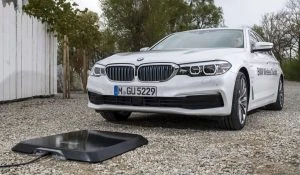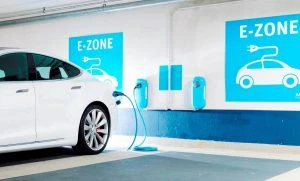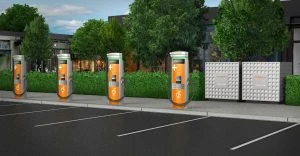Electric Vehicles (EVs)
BMW's EV Wireless Charging

BMW’s Wireless Charging
The new BMW 5-Series iPerformance models boast some very cool ‘world-first’ technology. Available factory-fitted with a fully integrated inductive charging facility means that you can arrive home, park over a ground pad (the inductive charging facility/station) and hey-presto your car charges up, ready for your next trip away.
BMW’s Wireless Charging consists of the GroundPad (an inductive charging station), that can be installed either in a garage or outdoors, and the CarPad, which is fixed to the underside of the vehicle will connect to the GroundPad once parked appropriately. This technology is available as an option on the new BMW 530e iPerformance model. The GroundPad generates a magnetic field that induces an electric current in the CarPad, which then charges the battery in the car.
BMW’s 530e iPerformance model has the parking systems that help the driver to manoeuvre into the correct parking position over the GroundPad using a WiFi connection between the charging station and the vehicle. Once the connection has been made, an overhead view of the car and its surroundings then appears in the car’s display screen with coloured lines that help guide the driver into position. An icon shows up on the screen when the correct parking position is reached for the process of inductive charging. BMW say the position for parking over the top of the GroundPad isn’t difficult to locate as the position can deviate by up to 7 cm longitudinally and up to 14 cm laterally – so it has plenty of buffering for getting a good connection. To easy!
We already are becoming familiar with the wireless charging systems inside many new cars from different manufacturers where mobile phones and electric toothbrushes can be wirelessly charged inside the car. BMW says its wireless charging uses the same inductive charging technology already widely used for supplying power to devices such as these.
BMW has unveiled a wireless charging system that will be available in Germany, followed shortly by the UK, the US, Japan and China. It’s nice to be able to boast this technology and do away with cords and manual contraptions for charging your hybrid. Germany and Europe seem to be leading the way with cutting edge EV technology, and this inductive charging system, created by BMW, will set the ball rolling for other manufacturers to follow suit.
I can imagine, like BMW, a world where you just pull up to your car park in the city, and the wireless inductive charging facility that’s set in place, in the road, underneath your EV will charge up your car while you duck into the café for a coffee or buy the necessary office equipment for your business. This is all pretty cool technology!
EV Ponderings

EV Networking
With all the fuss and excitement of electric vehicles paving the way of the future it’s worth pondering what sort of new electric-vehicle technology could be part of our automotive future. Interesting current discussion regarding what sort of electric-vehicle (EV) fuel stations, networking and technology Australia might employ is necessary for keeping the Australian EV fleet ready for the road. Plenty of excellent EV and EV-infrastructure planning and management has to happen now for us to get the best EV product rolled out for our country.
EVs need a simple and accessible recharging station that’s always handy – whether it be at home or on the move. If we have too few power-up stations available, then the incentive to buy an EV becomes less appealing to the public. At present the best EV technology manages to get some of the EV cars travelling around 300-to-400 km in ideal conditions before they require a recharge of their batteries. Many cars, in real life, can hardly make it to 200 km before they require a top-up. This makes country folk who travel large distances unlikely to want to buy a new EV – particularly if there is no handy recharge stations on-route.
Is it feasible to place powering-up stations every 100 km – or so – along a main arterial route between cities? The answer is yes, and it is happening in places like Germany where German carmakers hope a network of high-power charging stations they are rolling out with Ford will set an industry standard for plugs and protocols that will give them the edge over other electric car rivals and manufacturers. This competition is encouraging EV charging stations to be put in quickly across some of their main roads, making it easier to top-up the batteries on longer drives. EV station points are slowly growing inside Australia’s main cities, but little is being done with regards to connecting the main centres with additional intercity recharging stations. The sooner this is done, then the sooner we’ll see a big growth in Australian EV sales.
Connecting the EV power stations to the main grid is relatively straight forward. However, it would be even better to have isolated EV micro grids where each EV power station can generate its own power for recharging vehicles so that any looming main-grid power outages are isolated from the micro grids. When everybody and every-business in Australia switches to buying themselves a new EV, then it would seem a great doorway to causing nationwide havoc if some unseemly group takes out the major power stations across Australia! Having a micro-grid that sources Australia’s abundant solar and wind energy could also tick the right boxes.
An interesting EV progression in Sweden is the creation of an electrified road (the world’s first) that can charge EVs as they drive along, potentially helping to cut the high cost of electric cars. An electrified rail embedded in the tarmac of the 2 km road charges an EV truck automatically as it travels above it. A movable arm attached to the truck detects the rail’s location in the road, and charging stops when the vehicle is overtaking or coming to a halt. The system also calculates the vehicle’s energy consumption, which enables electricity costs to be debited per vehicle and per user. Could Australia embrace this type of innovation and join Sweden in leading the way forward, allowing electric cars to be even cheaper than fossil fuel ones?
The new BMW i3 and i3s, Hyundai IONIQ, Jaguar I-PACE, Nissan LEAF and Renault Kangoo ZE are some of the latest EVs arriving in Australia. I would encourage Australia to think outside the square and get onto the EV and power station new wave of technology for powering our nations new fleet of EVs. Australia could even create their own unique plug-in technology and high-output stations for the best environmentally-friendly Australian EV system.
Are you an EV driver? If you are, or even if you are taken by this new breed of vehicle, are there any items and processes you would like to see put in place so as we can all enjoy a premium Australia EV network?

EV Networking